A traditional Maharashtrian dessert Tilachi Vadi is specially made to celebrate the Makar Sankrant festival. With earthy roasted sesame seeds, peanuts, and buttery-rich jaggery these sweet treats are laced with cardamom and nutmeg and are easy to make.
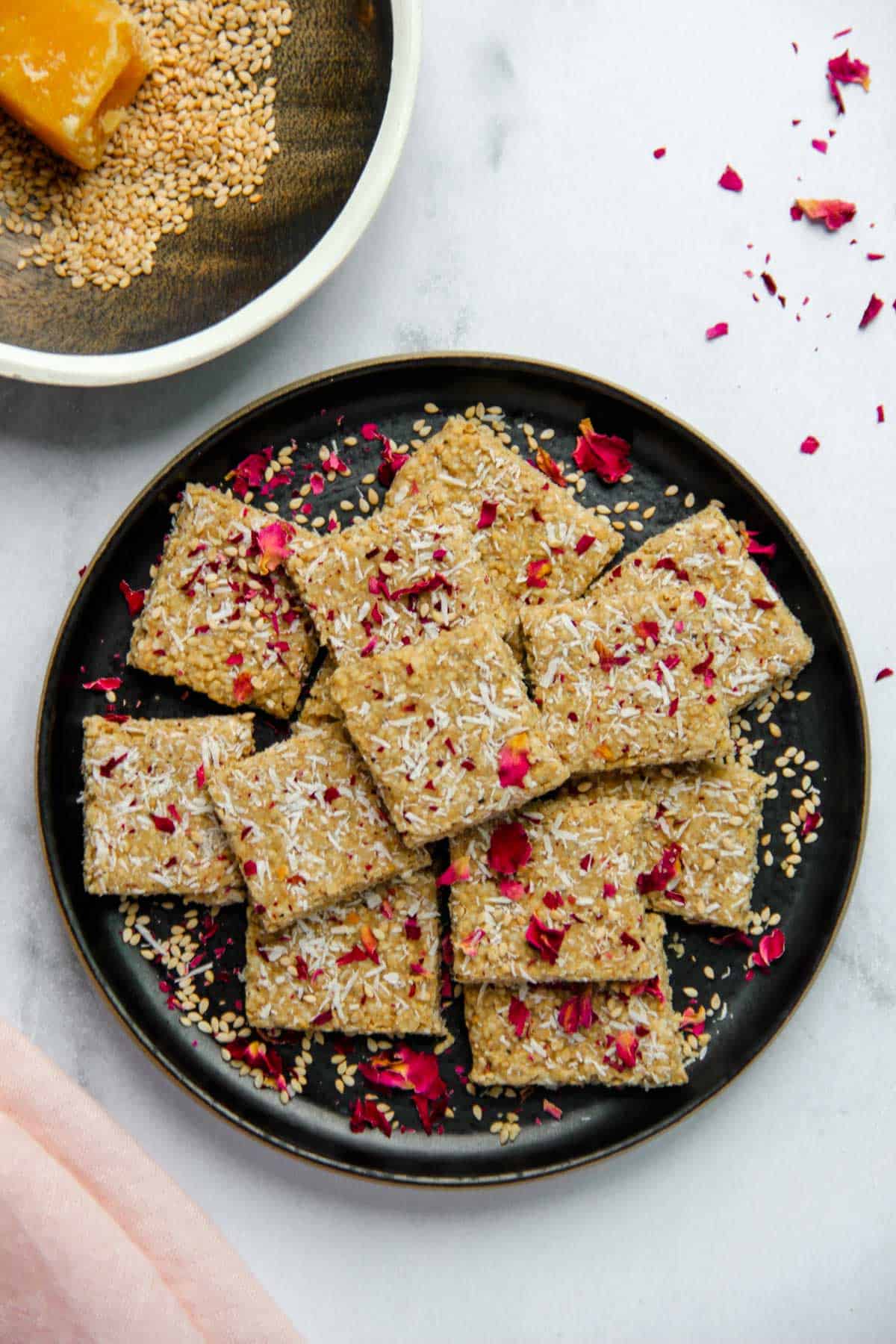
Want to Save This Recipe?
Enter your email & I'll send it to your inbox. Plus, get great new recipes from me every week!
By submitting this form, you consent to receive emails from Minstry of Curry
Jump to:
What is Tilachi Vadi
Til(sesame seeds)-Vadi(small squares) are earthy sweet treats made with sesame seeds and jaggery during winter months in Western India. Also known as "Mau (soft) Tilachi Vadi", it has a softer texture that is easier to bite into making it especially good for kids and the elderly. A similar dessert known as "Til Chikki" is also made in India, and the difference is that the Til Chikki is crunchy and is made using sugar or jaggery syrup.
What is Jaggery
Jaggery also known as "Gur" or "Gud" is a sweetener with a rich buttery molasses-like flavor that is commonly used in Indian cooking. It is a less refined cane sugar with a significant amount of molasses in it. Jaggery is especially consumed more in the winter months in India.
Readily available in Indian grocery stores, Jaggery comes in various shades from golden brown to dark brown. I always buy "Kolhapuri Jaggery" (Laxmi or Anand Brand) as it is moist, rich in taste, and without any additives, Some of my favorite Indian dessert recipes to use Jaggery are - Puran Poli, Ukadiche Modak, and Fried Modak.
Tamarind Chutney uses jaggery to balance the sour-tart tamarind and to get that perfect sweet tangy flavor. While a little bit of jaggery balances the spices in Indian curries like Stuffed Tomatoes and Black Eyed Peas Curry.
Ingredients
- Sesame Seeds - I like to use brown sesame seeds but you can also use white ones.
- Jaggery - Use soft and moist Kolhapuri jaggery that helps bind the ingredients together. Here in the US, I use the Laxmi brand or Anand Kolhapuri jaggery.
- Peanuts - raw unshelled peanuts available in Indian grocery stores are a huge time saver as you do not have to remove the skin. If you have regular peanuts, simply remove and discard the skin after they are roasting and cooling them
- Coconut - unsweetened dry shredded or desiccated coconut is always added in the traditional recipe but you can also skip it
- Ghee - helps with melting the jaggery evenly and adds a rich aroma
- Spices - ground cardamom and nutmeg add a delicate floral aroma to the Vadi

How to Make Tilachi Vadi
- Dry roast sesame seeds on medium heat for 3 to 5 minutes. Once the sesame seeds start to pop and get aromatic, reserve them in a bowl and allow them to cool down.
- In the same pan add the peanuts and roast them on medium heat for 2 to 3 minutes or until you start seeing light brown spots on them. Reserve them in a bowl and allow them to cool down.
- Next roast the coconut in the same pan for a minute or until it starts to get light brown. Promptly remove the coconut from the pan and into a bowl to cool down.
- Add cooled sesame seeds to a food processor or blender and process until it turns into a coarse powder. Take out in a medium bowl.
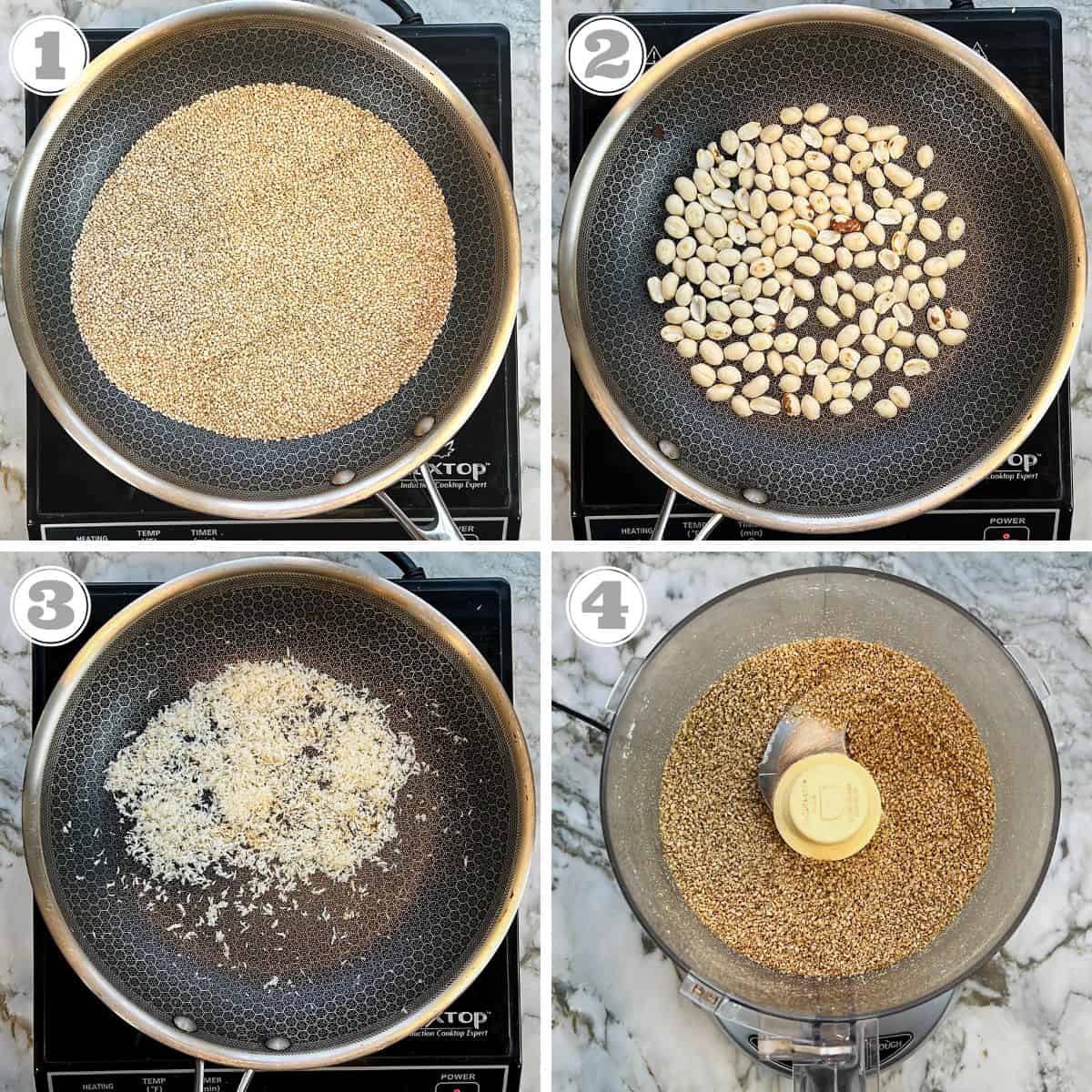
- Repeat the process with peanuts and coconut and add them to the bowl along with sesame seeds.
- Add cardamom, nutmeg, and salt to the bowl and mix well.
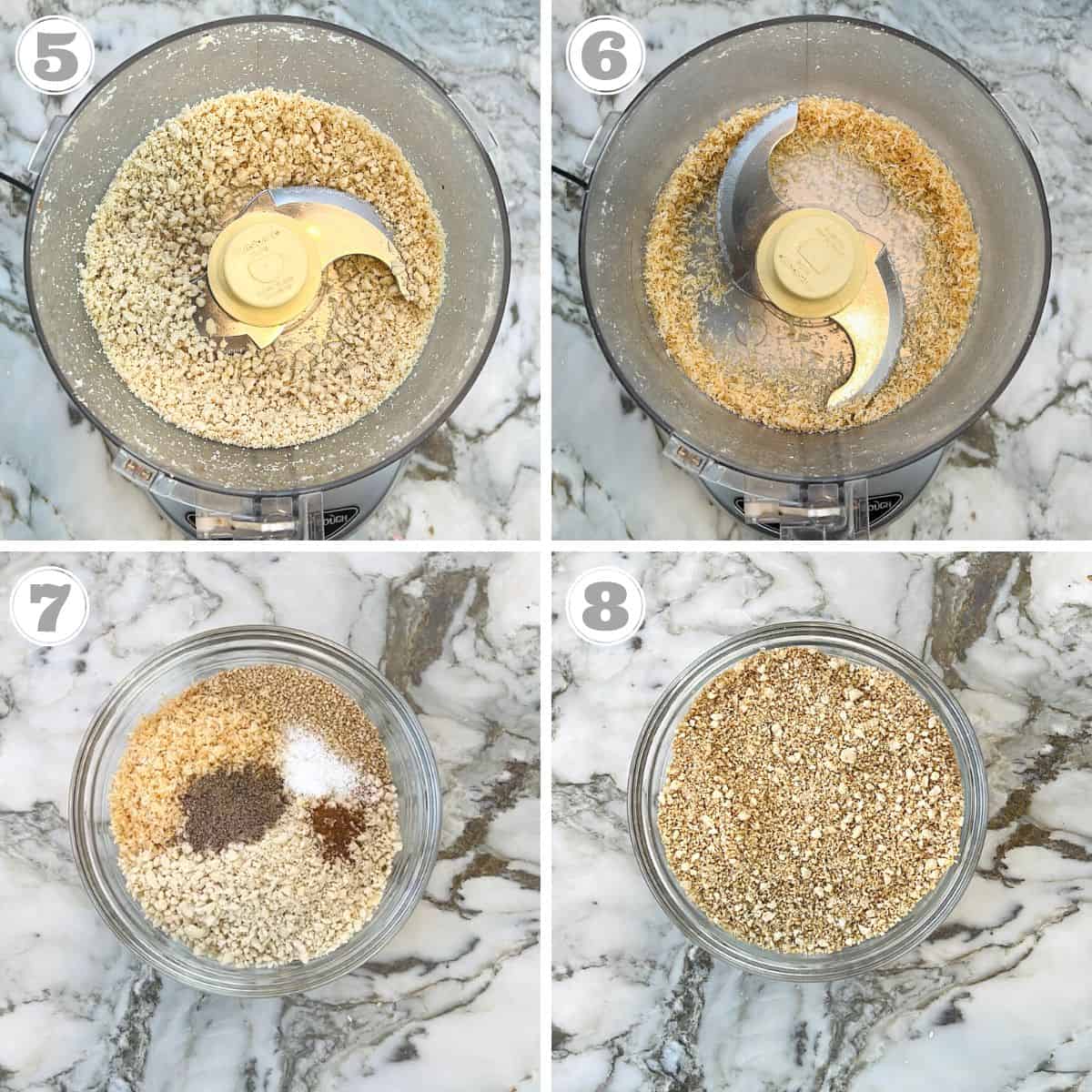
- Wipe the pan with a dry paper towel. Add ghee, jaggery, and water to the pan and cook on low heat as the jaggery melts
- The jaggery will start to bubble and look foamy-white on the top
- Turn the heat off and stir in the sesame seed mixture to it
- Mix well
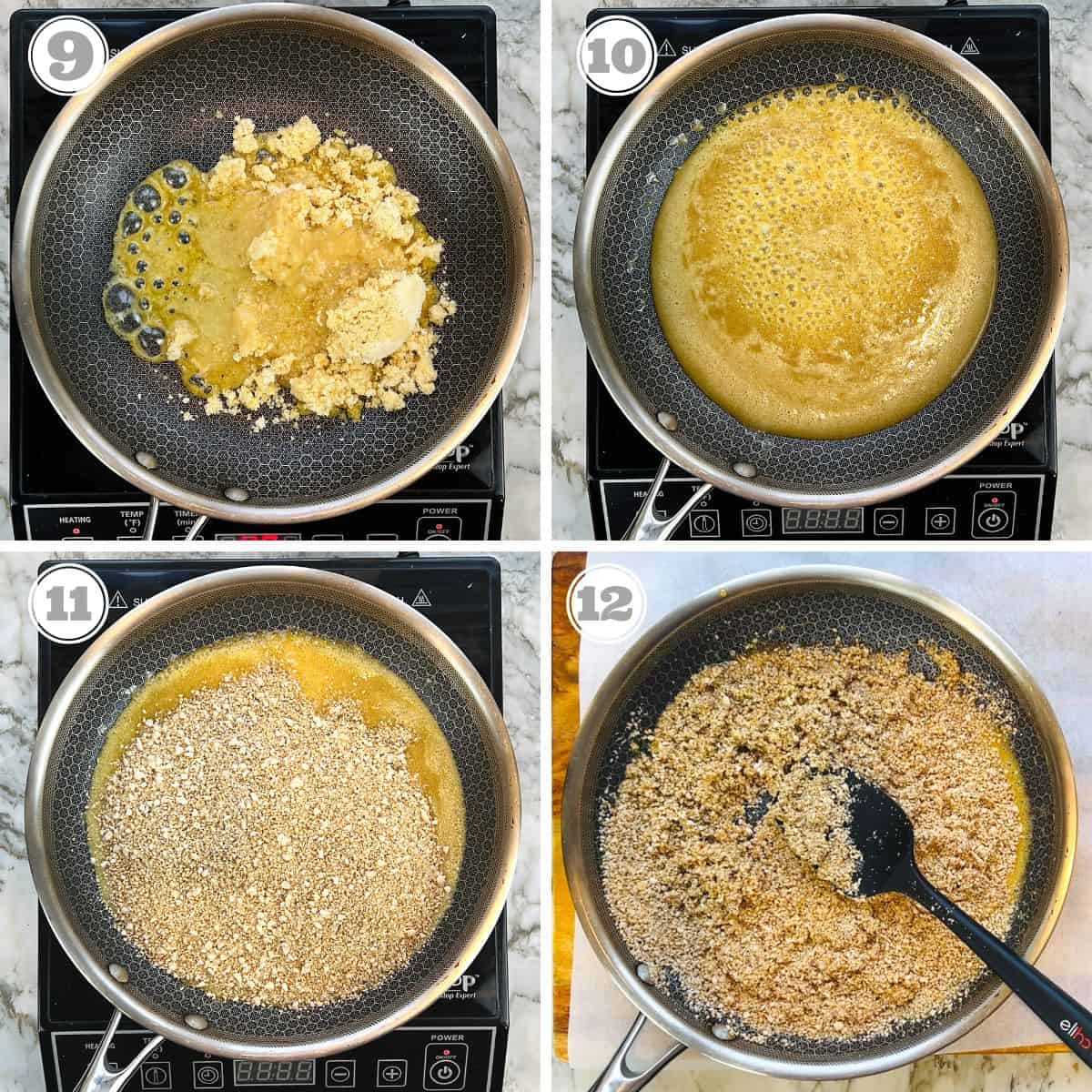
- Pour the mixture on a parchment-lined cutting board and spread it into an 8 X 8-inch square by pressing down with a silicone spatula. Note: You can also use a rolling pin greased with ghee to spread the mixture.
- Even out the sides to form a square.
- Garnish with grated coconut and rose petals if you like and press them down with a rolling pin or silicone spatula
- Next, cut it into small one to two-inch squares (Vadi) and allow them to cool down for 10 minutes before separating each piece.
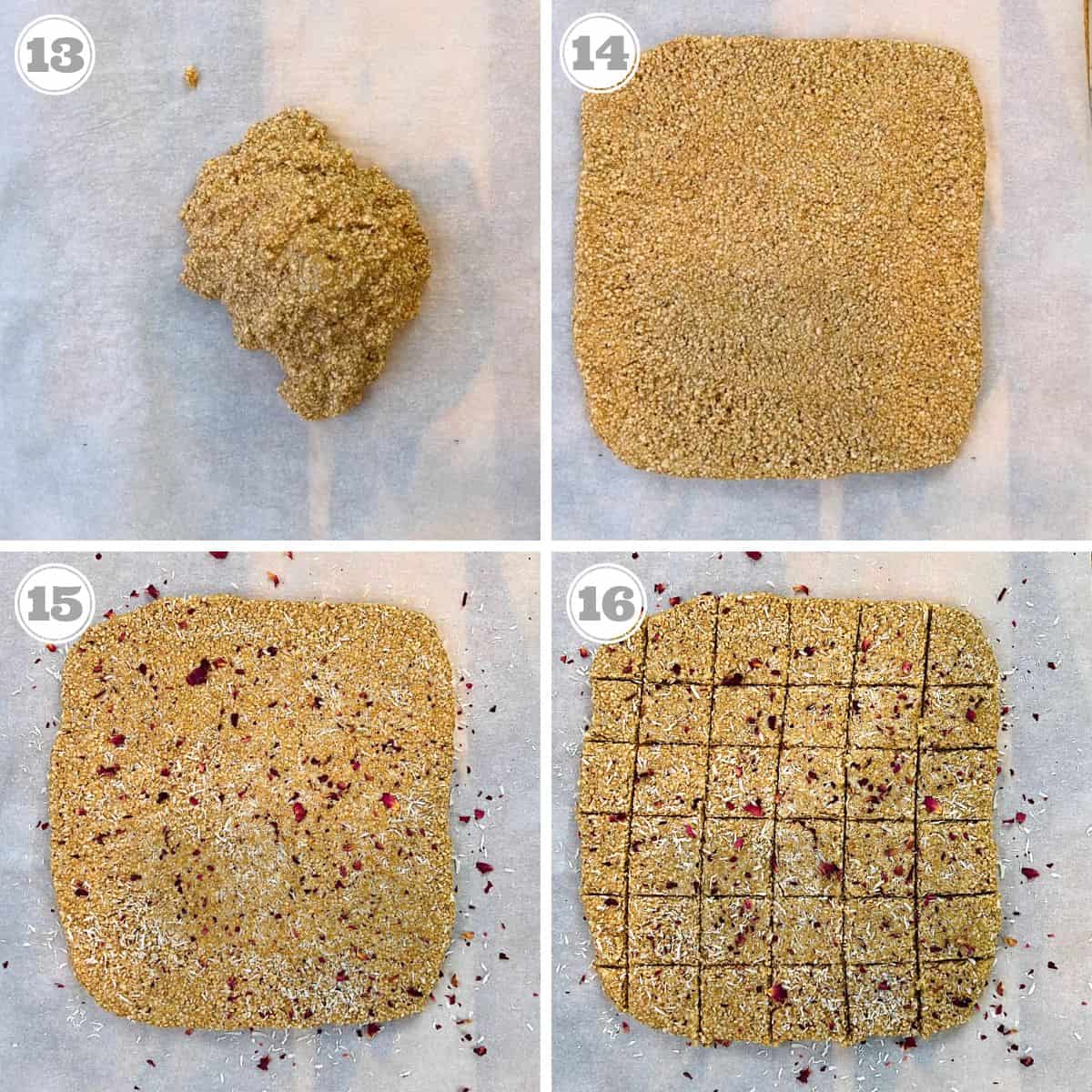
Storing
Store at room temperature in an air-tight container for up to 2 weeks.

Tips for Perfect Tilachi Vadi
- Roast the sesame seeds, peanuts, and coconut individually on low-medium heat, stirring them constantly so they do not burn
- Sesame seeds will start to pop and fill your kitchen with earthy aromas when they are roasted
- Use soft and moist Kolhapuri jaggery that helps bind the ingredients together. Here in the US, I use the Laxmi brand or Anand Kolhapuri jaggery.
- Use a food processor to grate the jaggery. Grated jaggery melts quickly and evenly
- If you are not using parchment paper, remember to grease the baking sheet or cutting board with some ghee
- Spread the mixture and cut promptly as it will start to harden in minutes
More Sankrant Dessert Recipes
Recipe
Tilachi Vadi (Sesame Burfi)
Recipe Video
Ingredients
- 1 cup sesame seeds I use brown sesame seeds
- ½ cup peanuts raw, preferably de-skinned
- ¼ cup grated dry coconut unsweetened dessicated coconut
- 1 teaspoon ground cardamom
- ⅛ teaspoon nutmeg powder
- ⅛ teaspoon kosher salt
- 1½ cups Kolhapuri jaggery grated
- 2 tablespoons water
- 2 teaspoons ghee
Optional Garnish
- 1 tablespoon shredded dry coconut unsweetened dessicated coconut
- 1 tablespoon edible dried rose petals
Instructions
- Line a baking sheet or cutting board with parchment paper.
- In a non-stick pan dry roast sesame seeds on medium heat for 3 to 5 minutes. Once the sesame seeds start to pop and get aromatic, reserve them in a bowl and allow them to cool down.
- In the same pan add the peanuts and roast them on medium heat for 2 to 3 minutes or until you start seeing light brown spots on them. Reserve them in a bowl and allow them to cool down. (Note: If you are using peanuts with skin on, remove and discard the skin once they are completely cooled)
- Next roast the coconut in the same pan for a minute or until it starts to get light brown. Promptly remove the coconut from the pan and into a bowl to cool down.
- Add cooled sesame seeds to a food processor or blender and process until it turns into a coarse powder. Take out in a medium bowl. Repeat the process with peanuts and coconut and add them to the bowl along with sesame seeds.
- Add cardamom, nutmeg, and salt to the bowl and mix well.
- Wipe the pan with a dry paper towel. Add ghee, jaggery, and water to the pan and cook on low heat until the jaggery is fully melted. The jaggery will start to bubble and look foamy-white on the top. Turn the heat off and stir in the sesame seed mixture to it.
- Pour the mixture on the parchment-lined cutting board and spread it into an 8 X 8-inch square by pressing down with a silicone spatula. Note: You can also use a rolling pin greased with ghee to spread the mixture. Even out the sides to form a square.
- Garnish with grated coconut and rose petals if you like and press them down with a rolling pin or silicone spatula
- Next, cut it into small one to two-inch squares (Vadi) and allow them to cool down for 10 minutes before separating each piece.
- Store at room temperature in an air-tight container for up to 2 weeks.
Notes
- Roast the sesame seeds, peanuts, and coconut individually on low-medium heat, stirring them constantly so they do not burn
- Sesame seeds will start to pop and fill your kitchen with earthy aromas when they are roasted
- Use soft and moist Kolhapuri jaggery that helps bind the ingredients together. Here in the US, I use the Laxmi brand or Anand Kolhapuri jaggery.
- Use a food processor to grate the jaggery. Grated jaggery melts quickly and evenly
- If you are not using parchment paper, remember to grease the baking sheet or cutting board with some ghee
- Spread the mixture and cut promptly as it will start to harden in minutes






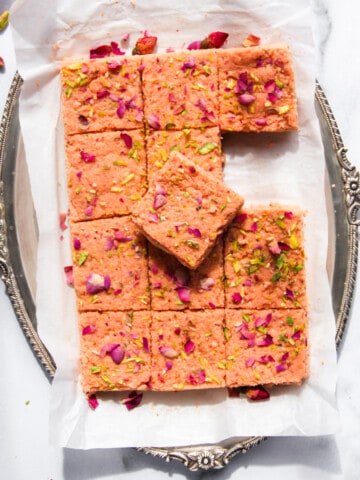
Poornima says
Really delicious recipe. Whole family loved it. Thank you